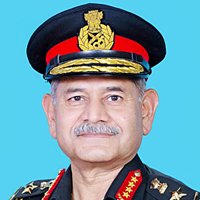INDIAN ARMED FORCES CHIEFS ON OUR RELENTLESS AND FOCUSED PUBLISHING EFFORTS

The insightful articles, inspiring narrations and analytical perspectives presented by the Editorial Team, establish an alluring connect with the reader. My compliments and best wishes to SP Guide Publications.

"Over the past 60 years, the growth of SP Guide Publications has mirrored the rising stature of Indian Navy. Its well-researched and informative magazines on Defence and Aerospace sector have served to shape an educated opinion of our military personnel, policy makers and the public alike. I wish SP's Publication team continued success, fair winds and following seas in all future endeavour!"

Since, its inception in 1964, SP Guide Publications has consistently demonstrated commitment to high-quality journalism in the aerospace and defence sectors, earning a well-deserved reputation as Asia's largest media house in this domain. I wish SP Guide Publications continued success in its pursuit of excellence.
- The layered Air Defence systems that worked superbly, the key element of Operation Sindoor
- Operation Sindoor | Day 2 DGMOs Briefing
- Operation Sindoor: India strikes back with Precision and Purpose
- Operation Sindoor: Resolute yet Restrained
- India’s Operation Sindoor Sends a Clear Message to Terror and the World – ‘ZERO TOLERANCE’
- Japan and India set forth a defence cooperation consultancy framework, talks on tank and jet engines
- Terrorist Attack in Pahalgam in Kashmir: Unfolding a long surgical war against PAK
- Lt General Pratik Sharma takes over Command of Indian Army's Northern Command
DARPA seeks multi-band, portable sensor to provide clear imagery to war-fighters
Clip-on or helmet-mounted camera system would fuse useful aspects of visible, near infrared, and infrared images into a single shot under all weather and visibility conditions.
It is often the case with new military technologies that warfighters need to adjust to their equipment to access needed capabilities. As missions shift, however, and warfighters are required to work in smaller teams and access more remote locations, it is technology that must adapt if it is to remain useful. Desirable features for many new man-portable systems include small size, light weight, minimal power consumption, low cost, ease of use, multifunctionality and, to the extent possible, network friendliness.
The Defence Advanced Research Projects Agency (DARPA) created the Pixel Network for dynamic visualisation programme, or PIXNET, to apply these features to the cameras and sensors used by dismounted war-fighters and small combat units for battlefield awareness and threat detection and identification. PIXNET aims to develop helmet-mounted and clip-on camera systems that combine visible, near infrared, and infrared sensors into one system and aggregate the outputs. PIXNET technology would ingest the most useful data points from each component sensor and fuse them into a common, information-rich image that can be viewed on the war-fighter’s heads-up display, and potentially be shared across units.
The base technologies DARPA proposes to use already exist and are currently used by war-fighters. However, these devices typically have dedicated functionality, operate independently of one another and provide value only to the immediate operator. Through PIXNET, DARPA seeks to fuse the capabilities of these devices into a single multi-band system, thus alleviating physical overburdening of warfighters, and develop a tool that is network-ready, capable of sharing imagery with other war-fighters.
“Existing sensor technologies are a good jumping-off point, but PIXNET will require innovations to combine reflective and thermal bands for maximum visibility during the day or night, and then package this technology for maximum portability. What we really need are breakthroughs in aperture design, focal plane arrays, electronics, packaging and materials science,” said Nibir Dhar, DARPA programme manager for PIXNET. “Success will be measured as the minimisation of size, weight, power and cost of the system and the maximisation of functionality.”
To help boost processing power while minimising size and energy use, PIXNET sensors will interface wirelessly with an Android-based smart phone for fusing images and for networking among units. Although the primary focus of PIXNET is on sensor development, proposers are instructed to develop whatever apps are necessary to achieve the desired functionality for phone and camera.
In addition to technological innovation, proposers are encouraged to develop plans for transitioning the low-cost camera system into manufacturing. In the case of the helmet-mounted system, DARPA’s preferred cost goal in a manufacturing environment producing 10,000 units per month is $3,300 per unit.





